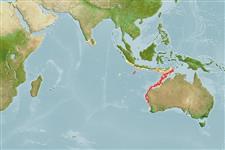Environment: milieu / climate zone / depth range / distribution range
นิเวศวิทยา
เกี่ยวกับทะเล,น้ำเค็ม สัตว์น้ำหน้าดิน; ระดับความลึก 150 - 280 m (Ref. 27966). Tropical
Eastern Indian Ocean: southern Indonesia and northern Australia.
ขนาด / น้ำหนัก / Age
Maturity: Lm ? range ? - ? cm
Max length : 23.0 cm SL เพศผู้/กระเทย; (Ref. 27966)
ก้านครีบอ่อนที่ก้น: 15. Head depressed. Body without large scute-like spines. Infraorbital bones forming a strong ridge, confluent with uppermost preopercular spine and having 4-6 spines (Ref. 40506).
Occurs over soft bottom of the continental shelf and continental slope. Benthic (Ref. 75154).
Life cycle and mating behavior
Maturities | การสืบพันธุ์ | Spawnings | Egg(s) | Fecundities | ตัวอ่อน
Imamura, H. and L.W. Knapp, 1998. Review of the genus Bembras Cuvier, 1929 (Scorpaeniformes: Bembridae) with description of three new species collected from Australia and Indonesia. Ichthyol. Res. 45(2):165-178. (Ref. 27966)
IUCN Red List Status (Ref. 130435)
Threat to humans
Harmless
Human uses
เครื่องมือ
Special reports
Download XML
แหล่งที่มาจากอินเตอร์เน็ต
Estimates based on models
Preferred temperature (Ref.
123201): 14.5 - 20.4, mean 16.7 °C (based on 12 cells).
Phylogenetic diversity index (Ref.
82804): PD
50 = 0.5332 [Uniqueness, from 0.5 = low to 2.0 = high].
Bayesian length-weight: a=0.00389 (0.00180 - 0.00842), b=3.12 (2.94 - 3.30), in cm total length, based on all LWR estimates for this body shape (Ref.
93245).
ระดับชั้นอาหาร (Ref.
69278): 3.7 ±0.4 se; based on size and trophs of closest relatives
Fishing Vulnerability (Ref.
59153): Low vulnerability (18 of 100).
